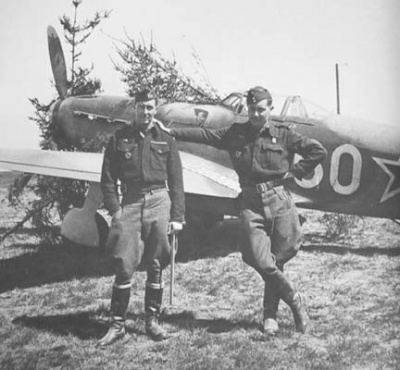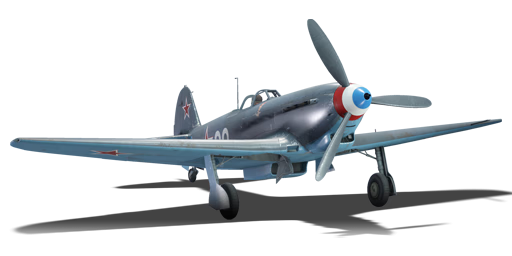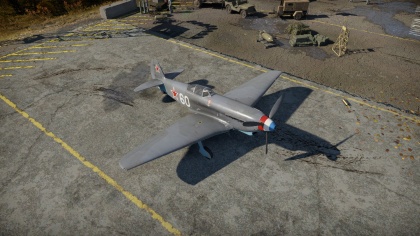Challe's Yak-9T (France)
Contents
| This page is about the French fighter Challe's Yak-9T (France). For other uses, see Yak-9 (Family). |
Description
Challe's ▄Yak-9T is a Rank III premium French fighter
with a battle rating of 3.7 (AB) and 4.0 (RB/SB). This aircraft was introduced in Update 1.73 "Vive la France", released later to commemorate the 75th anniversary of the French-Soviet squadron "Normandie-Niemen" on 24 November 2017. This version is modelled after the Yak-9 flown by French pilot René Challe.
Challe's Yak-9T has so far been made available only during the 75th-anniversary event for the Normandie Niemen Soviet-French squadron as a purchasable premium.
General info
Flight Performance
| Characteristics | |||||||
|---|---|---|---|---|---|---|---|
| Stock | |||||||
| Max Speed (km/h at ?,000 m) |
Max altitude (meters) |
Turn time (seconds) |
Rate of climb (meters/second) |
Take-off run (meters) | |||
| AB | RB | AB | RB | AB | RB | ||
| ? | ? | ?,000 | ??.? | ??.? | ??.? | ??.? | ??? |
| Upgraded | |||||||
| Max Speed (km/h at ?,000 m) |
Max altitude (meters) | Turn time (seconds) | Rate of climb (meters/second) |
Take-off run (meters) | |||
| AB | RB | AB | RB | AB | RB | ||
| ? | ? | ?,000 | ??.? | ??.? | ?.? | ?.? | ? |
Details
| Features | ||||
|---|---|---|---|---|
| Combat flap | Take-off flap | Landing flap | Air brakes | Arrestor gear |
| X | X | X | X | X |
| Limits | ||||
|---|---|---|---|---|
| Wing-break speed (km/h) |
Gear limit (km/h) |
Combat flap (km/h) |
Max Static G | |
| + | - | |||
| ??? | ??? | ??? | ~?? | ~? |
| Optimal velocities | |||
|---|---|---|---|
| Ailerons (km/h) |
Rudder (km/h) |
Elevators (km/h) |
Radiator (km/h) |
| < ??? | < ??? | < ??? | > ??? |
| Compressor (RB/SB) | ||
|---|---|---|
| Setting 1 | ||
| Optimal altitude | 100% Engine power | WEP Engine power |
| ?,??? m | ??? hp | ?,??? hp |
Survivability and armour
- 64 mm Bulletproof glass in cockpit front and rear.
- 8 mm Steel plate in the pilot's seat.
Armaments
Offensive armament
Challe's Yak-9T (France) is armed with:
- 1 x 37 mm NS-37 cannon, nose-mounted (30 RPG = 30 total)
- 1 x 12.7 mm Berezin UB machine gun (200 RPG = 200 total)
Usage in the battles
The Yakovlev 9-T or Yak-9 as it is most popularly referred to in-game, being the most popular of the Yak 9 variants, is best played differently depending on the situation the pilot finds him/herself in.
To begin, make sure that you take off and immediately climb. A twenty-degree angle may be too much to handle depending on the number of upgrades purchased on the aircraft, so initially, a fifteen-degree climb will suffice. With it, the pilot keeps much-needed speed and agility. Altitude advantage over your opponent is always preferred, and most pilots of the tier that the Yak 9T fights, do not choose to climb over 2,000 Meters (6,561 feet) A good altitude to climb to is 3,000 Meters (9,842 feet) to gain the altitude advantage over the enemy. Be advised this will not always be the case and some enemies will climb above you, if this happens, try to make them bleed energy until they are slower than you and turn-fight them.
At high altitude, the Yak 9T is best suited to energy fighting, which means using the Yak's good energy retention to zoom at an opponent, shoot at them, and then climb up and turn back to your opponent and give chase. They Yak at mid to low altitude is best suited to turn-fighting against all nations except for the Japanese. If facing the Japanese, use the same energy fight tactics as stated above, as Japanese planes will be unable to give chase due to low energy retention of their lightweight aircraft. The Yak-9T comes equipped with flaps, it is critical you use them, as performance is significantly increased in a turn-fight with them opened.
The Yak 9T and typically speaking, all Yak aircraft suffer from constant engine overheat which requires properly watching the temperature to ensure it does not stay critical for too long or the engine will die and the plane becomes subject to the laws of gravity. Keep eyes on the temperature at all times. Best advice is to keep the throttle at 90% or lower when not in combat. The Yak-9T is best suited for flying in colder maps, however, if on a hot map, gain altitude and cruise at 85-90% throttle.
Manual Engine Control
| MEC elements | ||||||
|---|---|---|---|---|---|---|
| Mixer | Pitch | Radiator | Supercharger | Turbocharger | ||
| Oil | Water | Type | ||||
| Not controllable | Controllable Automatic pitch |
Controllable | Not controllable | Combined | Controllable | Not controllable |
Modules
| Tier | Flight performance | Survivability | Weaponry |
|---|---|---|---|
| IA | |||
| II | |||
| III | |||
| IV |
Pros and cons
Pros:
- Cannon is quite accurate and powerful
- Has 30 shells for the 37 mm and reasonably high rate of fire compared to its calibre
- Decent manoeuvrability
- Cannon can knock out medium tanks with several hits in the side or rear.
Cons:
- The 37 mm chews through ammunition quickly; afterwards, you only have a single 50. Cal machine gun (unless you wait for reload in arcade or return to base in realistic or simulator battles)
- 37 mm has high recoil
- Lousy high-altitude performance.
History

The Yak-9 was a Soviet single-engine fighter of the WWII era. It was the first combat aircraft designed by Alexander Yakovlev's construction bureau. The most mass-produced Soviet fighter of the war, it remained in production from October 1942 to December 1948, with a total of 16,769 built.
The Yak-9 was a further modification of the Yak-1 and Yak-7. In its core design, it was a redesign of the Yak-7. With few external differences, Yak-9 was at the same time much more advanced internally. This is not unexpected, as almost two years of design and combat experience of the Yak series went into the Yak-9. Also, at the time aluminium was in much greater supply than it had been two years previously at the start of the war. Amongst other things, the use of metal allowed the plane’s weight to be significantly reduced, meaning that more fuel could be stored and that the aircraft could be equipped with more powerful armament and more specialized equipment.
The Yak-9T variant, for instance, had an incredibly powerful 37mm NS-37 cannon firing through the propeller hub. Due to the length of the gun barrel, the pilot’s seat had to be moved 40 cm aft, and the airframe was strengthened. The variant carried 30 to 32 cannon shells, as well as 200-220 rounds for the synchronized UB machine gun. Salvo weight for the variant was a whopping 3.74 kg (8.24 lbs). The 37mm gun allowed for firing at increased ranges, up to 1,200 yards against bomber formations, and 500-600 yards against single non-manoeuvring bombers. The Yak-9T was also successful against ground targets. Armour-piercing shells, fired from 500 yards at an angle of 45 degrees, could penetrate 30 mm of armour. In late 1943, the Yak-9T was used in an anti-shipping role in the Black Sea. A total of 2,748 Yak-9s were built between March 1943 and June 1945.
Media
An excellent addition to the article will be video guides, as well as screenshots from the game and photos.
Read also
Links to the articles on the War Thunder Wiki that you think will be useful for the reader, for example,
- reference to the series of the aircraft;
- links to approximate analogues of other nations and research trees.
Sources
Paste links to sources and external resources, such as:
- topic on the official game forum;
- page on aircraft encyclopedia;
- other literature.





